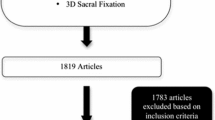Abstract
Background
The incidence of pelvic fractures in trauma patients is reported to be 3–8.2%, with roughly half of these fractures being caused by high energy injuries with a potential for catastrophic hemorrhage and death. Indications for internal fixation of anterior pelvic ring are controversial. Because of fears of disturbing the pelvic hematoma and causing additional hemorrhage, open reduction and internal fixation of pelvic ring disruption is routinely delayed. In contrast to conventional surgery, percutaneous screw fixation is gaining popularity in the treatment of pelvic and acetabular fractures mainly because of minimal soft tissue damage, less operative blood loss, early surgical intervention and comfortable mobilization of the patient. Fluoro-navigation is a new surgical technique in orthopedic trauma surgery. This study is to investigate clinical results of fluoro-navigation surgery in anterior pelvic ring fractures.
Materials and Methods
From January 2006 to October 2011, 23 patients with anterior pelvic ring fractures were treated with percutaneous cannulated screw under fluoro-navigation. There were 14 men and 9 women, with a mean age of 40.1 years (range 25–55). According to the AO and Orthopedic Trauma Association classification, there were seven A 2.1, two A 2.2, one A 2.3, six B 1.2, one B 2.1: 1, one B 2.2, one C 1.2, two C 1.3 and two C 2.3 types of fractures. Amongst these patients, 13 had posterior pelvic ring injuries, 8 had other injuries including urethral, lumbar vertebrae fractures and femoral fractures. All patients were operated when their general condition stabilized after emergency management. The mean time from injury to percutaneous screw fixation of the anterior pelvic ring fracture was 12 days (3–15 days). All the anterior ring fractures were fixed with cannulated screws by two senior surgeons. They were familiar with the navigation system and had gained much experience in the computer-assisted percutaneous placement of screws.
Results
A total of 32 screws were inserted, including 19 in the pubic ramis and 13 in the anterior acetabular columns. The average surgical time was 23.3 min/screw. The average time of X-ray exposure was 19.1 ± 2.5 s/screw. The virtual images of fluoro-navigation were compared with real-time X-rays during and after the surgery. Compared to the final position of the screw, the average deviated distance was 3.11 mm and the average trajectory difference was 2.81°. Blood loss during the operation was minimal (22.3 ml/screw). One screw (3.1%) deviated out of the fracture site during the operation. No superficial or deep infection occurred. No patient sustained recognized neurologic, vascular, or urologic injury as a result of the percutaneous screw fixation. All fractures united at the last followup.
Conclusions
Fluoro-navigation technique could become a safe, accurate, and fairly quick method for the treatment of anterior pelvic ring fractures. Standardization of the operative procedure and training are mandatory for the success of this procedure.
Similar content being viewed by others
References
Pohlemann T, Gänsslen A, Schellwald O, Culemann U, Tscherne H. Outcome after pelvic ring injuries. Injury 1996;27 Suppl 2:B31–8.
Wong JM, Bucknill A. Fractures of the pelvic ring. Injury 2013;12:pii: S0020-138300556-1.
Simonian PT, Routt ML Jr, Harrington RM, Tencer AF. Internal fixation of the unstable anterior pelvic ring: A biomechanical comparison of standard plating techniques and the retrograde medullary superior pubic ramus screw. J Orthop Trauma 1994;8:476–82.
Routt ML Jr, Kregor PJ, Simonian PT, Mayo KA. Early results of percutaneous iliosacral screws placed with the patient in the supine position. J Orthop Trauma 1995;9:207–14.
Hong G, Cong-Feng L, Cheng-Fang H, Chang-Qing Z, Bing-Fang Z. Percutaneous screw fixation of acetabular fractures with 2D fluoroscopy-based computerized navigation. Arch Orthop Trauma Surg 2010;130:1177–83.
Lin YC, Chen CH, Huang HT, Chen JC, Huang PJ, Hung SH, et al. Percutaneous antegrade screwing for anterior column fracture of acetabulum with fluoroscopic-based computerized navigation. Arch Orthop Trauma Surg 2008;128:223–6.
Keating JF, Werier J, Blachut P, Broekhuyse H, Meek RN, O’Brien PJ. Early fixation of the vertically unstable pelvis: The role of iliosacral screw fixation of the posterior lesion. J Orthop Trauma 1999;13:107–13.
Matta JM, Tornetta P. 3rd. Internal fixation of unstable pelvic ring injuries. Clin Orthop Relat Res 1996;8:129–40.
Bible JE, Choxi AA, Kadakia RJ, Evans JM, Mir HR. Quantification of bony pelvic exposure through the modified Stoppa approach. J Orthop Trauma 2014;28:320–3.
Kellam JF, McMurtry RY, Paley D, Tile M. The unstable pelvic fracture. Operative treatment. Orthop Clin North Am 1987;18:25–41.
Routt ML Jr, Simonian PT, Swiontkowski MF. Stabilization of pelvic ring disruptions. Orthop Clin North Am 1997;28:369–88.
Leighton RK, Waddell JP. Techniques for reduction and posterior fixation through the anterior approach. Clin Orthop Relat Res 1996;8:115–20.
Hinsche AF, Giannoudis PV, Smith RM. Fluoroscopy-based multiplanar image guidance for insertion of sacroiliac screws. Clin Orthop Relat Res 2002;2:135–44.
Norris BL, Hahn DH, Bosse MJ, Kellam JF, Sims SH. Intraoperative fluoroscopy to evaluate fracture reduction and hardware placement during acetabular surgery. J Orthop Trauma 1999;13:414–7.
Nolte LP, Beutler T. Basic principles of CAOS. Injury 2004;35 Suppl 1:S–A6–16.
Tian ZM. Clinical evaluation of neouronavigation and frameless stereotaxy in minimally invasive neourosurgery. Chin Med J 2001;81:1028–9.
Nolte LP, Visarius H, Arm E, Langlotz F, Schwarzenbach O, Zamorano L. Computer-aided fixation of spinal implants. J Image Guid Surg 1995;1:88–93.
Xu P, Wang H, Liu ZY, Mu WD, Xu SH, Wang LB, et al. An evaluation of three-dimensional image-guided technologies in percutaneous pelvic and acetabular lag screw placement. J Surg Res 2013;185:338–46.
Ochs BG, Gonser C, Shiozawa T, Badke A, Weise K, Rolauffs B, et al. Computer-assisted periacetabular screw placement: Comparison of different fluoroscopy-based navigation procedures with conventional technique. Injury 2010;41:1297–305.
Author information
Authors and Affiliations
Corresponding author
Rights and permissions
About this article
Cite this article
Zhou, KH., Luo, CF., Chen, N. et al. Minimally invasive surgery under fluoro-navigation for anterior pelvic ring fractures. IJOO 50, 250–255 (2016). https://doi.org/10.4103/0019-5413.181791
Published:
Issue Date:
DOI: https://doi.org/10.4103/0019-5413.181791




